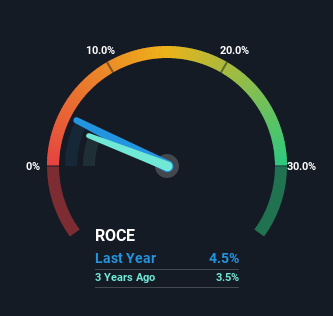[ad_1]
To find a multi-bagger stock, what are the underlying trends we should look for in a business? In a perfect world, we’d like to see a company investing more capital into its business and ideally the returns earned from that capital are also increasing. Basically this means that a company has profitable initiatives that it can continue to reinvest in, which is a trait of a compounding machine. Although, when we looked at Ruby Mills (NSE:RUBYMILLS), it didn’t seem to tick all of these boxes.
What is Return On Capital Employed (ROCE)?
For those that aren’t sure what ROCE is, it measures the amount of pre-tax profits a company can generate from the capital employed in its business. To calculate this metric for Ruby Mills, this is the formula:
Return on Capital Employed = Earnings Before Interest and Tax (EBIT) ÷ (Total Assets – Current Liabilities)
0.045 = ₹377m ÷ (₹11b – ₹2.2b) (Based on the trailing twelve months to December 2021).
So, Ruby Mills has an ROCE of 4.5%. Ultimately, that’s a low return and it under-performs the Luxury industry average of 14%.
View our latest analysis for Ruby Mills

While the past is not representative of the future, it can be helpful to know how a company has performed historically, which is why we have this chart above. If you’re interested in investigating Ruby Mills’ past further, check out this free graph of past earnings, revenue and cash flow.
What Does the ROCE Trend For Ruby Mills Tell Us?
In terms of Ruby Mills’ historical ROCE movements, the trend isn’t fantastic. Around five years ago the returns on capital were 6.6%, but since then they’ve fallen to 4.5%. However, given capital employed and revenue have both increased it appears that the business is currently pursuing growth, at the consequence of short term returns. If these investments prove successful, this can bode very well for long term stock performance.
On a side note, Ruby Mills has done well to pay down its current liabilities to 21% of total assets. So we could link some of this to the decrease in ROCE. What’s more, this can reduce some aspects of risk to the business because now the company’s suppliers or short-term creditors are funding less of its operations. Some would claim this reduces the business’ efficiency at generating ROCE since it is now funding more of the operations with its own money.
The Key Takeaway
Even though returns on capital have fallen in the short term, we find it promising that revenue and capital employed have both increased for Ruby Mills. These trends are starting to be recognized by investors since the stock has delivered a 16% gain to shareholders who’ve held over the last five years. Therefore we’d recommend looking further into this stock to confirm if it has the makings of a good investment.
Ruby Mills does come with some risks though, we found 5 warning signs in our investment analysis, and 2 of those are potentially serious…
While Ruby Mills may not currently earn the highest returns, we’ve compiled a list of companies that currently earn more than 25% return on equity. Check out this free list here.
Have feedback on this article? Concerned about the content? Get in touch with us directly. Alternatively, email editorial-team (at) simplywallst.com.
This article by Simply Wall St is general in nature. We provide commentary based on historical data and analyst forecasts only using an unbiased methodology and our articles are not intended to be financial advice. It does not constitute a recommendation to buy or sell any stock, and does not take account of your objectives, or your financial situation. We aim to bring you long-term focused analysis driven by fundamental data. Note that our analysis may not factor in the latest price-sensitive company announcements or qualitative material. Simply Wall St has no position in any stocks mentioned.
[ad_2]
Source link








